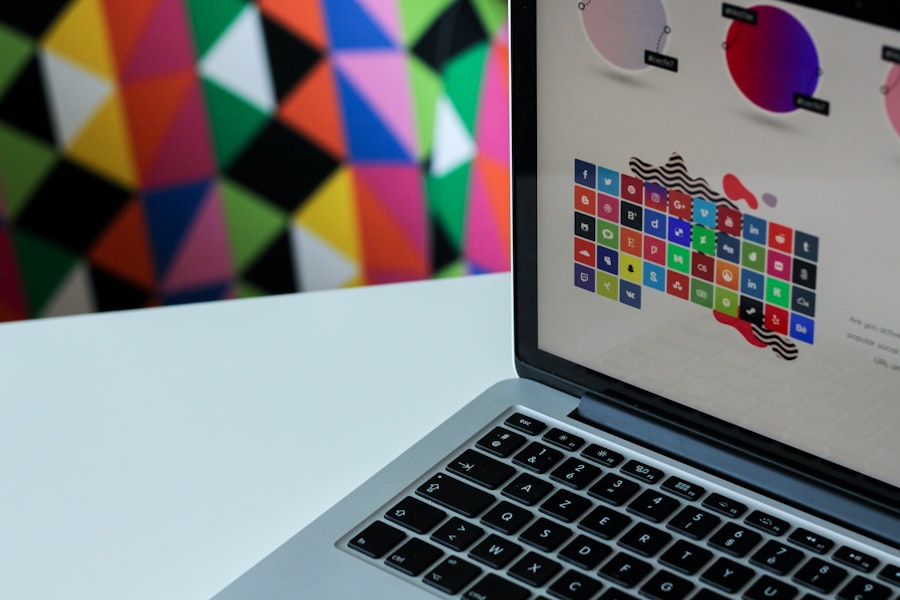
As I delve into the world of design, I find myself increasingly captivated by the transformative role that artificial intelligence (AI) plays in this field. The integration of AI into design processes is not merely a trend; it represents a fundamental shift in how we conceptualize, create, and execute design projects. From graphic design to architecture, AI is reshaping the landscape, enabling designers to push boundaries and explore new creative avenues.
This evolution is not just about efficiency; it’s about enhancing creativity and fostering innovation in ways that were previously unimaginable. The advent of AI in design has opened up a plethora of possibilities. I am particularly fascinated by how AI can analyze vast amounts of data to inform design decisions, allowing for a more informed and strategic approach.
This technology empowers designers to harness insights that can lead to more effective and engaging outcomes. As I explore this intersection of technology and creativity, I am eager to understand the implications of AI on the design process and how it can enhance my own work as a designer.
Key Takeaways
- AI is revolutionizing the design industry by enabling personalized and automated design processes.
- AI-driven personalization in design allows for tailored experiences and products based on individual preferences and behaviors.
- Generative design and AI are transforming the way designers approach problem-solving and innovation.
- AI in user experience design enhances the understanding of user behavior and preferences to create more intuitive and user-friendly designs.
- AI-enabled automation in design processes streamlines repetitive tasks and allows designers to focus on more creative and strategic aspects of their work.
AI-Driven Personalization in Design
Personalized Experiences through Data Analysis
One of the most exciting aspects of AI in design is its ability to drive personalization. In an age where consumers crave tailored experiences, I find it remarkable how AI can analyze user data to create designs that resonate on a personal level.
Enhanced User Engagement and Satisfaction
This level of personalization enhances user engagement and satisfaction, making my designs more impactful. Moreover, AI-driven personalization extends beyond mere aesthetics. It allows me to create dynamic experiences that adapt in real-time based on user interactions.
Dynamic Experiences through Real-Time Adaptation
For instance, I can design websites or applications that change their layout or content based on user behavior, ensuring that each visitor receives a unique experience tailored to their needs. This capability not only elevates the user experience but also fosters a deeper connection between the user and the design, ultimately leading to greater loyalty and retention.
Generative Design and AI

Generative design is another fascinating area where AI is making waves in the design industry. As I explore this concept, I am struck by the idea that AI can generate multiple design alternatives based on specific parameters set by the designer. This process allows me to explore a vast array of possibilities that I might not have considered otherwise.
The implications of generative design are profound. It not only accelerates the design process but also encourages experimentation and creativity.
I find myself inspired by the unexpected outcomes that generative design can produce, pushing me to think outside the box and embrace unconventional ideas. This synergy between human intuition and machine intelligence creates a collaborative environment where I can refine my designs while still maintaining my unique creative voice.
AI in User Experience Design
User experience (UX) design is an area where AI has become increasingly influential. As I navigate this field, I recognize that understanding user behavior is crucial for creating intuitive and engaging experiences. AI tools can analyze user interactions, providing insights into how people navigate websites or applications.
This data-driven approach allows me to identify pain points and areas for improvement, ultimately leading to more user-friendly designs. Additionally, AI can enhance UX through predictive analytics. By anticipating user needs and preferences, I can create interfaces that proactively address potential issues before they arise.
For example, if an AI system detects that users frequently abandon their shopping carts at a certain point in the checkout process, I can adjust the design to streamline that experience. This proactive approach not only improves usability but also increases conversion rates, making my designs more effective in achieving their intended goals.
AI-Enabled Automation in Design Processes
The automation capabilities of AI are revolutionizing design processes in ways that I find both exciting and practical. By automating repetitive tasks such as resizing images or generating variations of a design, I can free up valuable time to focus on more strategic aspects of my work. This efficiency allows me to allocate my creative energy toward ideation and innovation rather than getting bogged down by mundane tasks.
Moreover, AI-enabled automation can enhance collaboration within design teams. With tools that facilitate real-time feedback and version control, I can streamline communication and ensure that everyone is on the same page throughout the design process. This collaborative environment fosters creativity and allows for more dynamic brainstorming sessions, ultimately leading to better outcomes.
As I embrace these automated solutions, I find myself empowered to take on more ambitious projects with confidence.
AI-Infused Creativity in Design

While some may argue that AI threatens the essence of creativity in design, I believe it serves as a powerful tool that enhances my creative capabilities. By analyzing trends and patterns within vast datasets, AI can provide inspiration and insights that inform my design choices. For instance, when working on a branding project, I can utilize AI tools to explore color palettes, typography options, and visual styles that resonate with target audiences.
Furthermore, AI can assist in breaking through creative blocks. When I find myself stuck or uninspired, I can turn to AI-generated suggestions or mood boards that spark new ideas. This collaborative relationship between human creativity and machine intelligence allows me to explore uncharted territories in my work.
Rather than replacing my creative instincts, AI amplifies them, enabling me to produce designs that are both innovative and relevant.
Ethical Considerations in AI-Driven Design
As I embrace the benefits of AI in design, I am also acutely aware of the ethical considerations that accompany its use. The potential for bias in AI algorithms is a significant concern; if not carefully managed, these biases can perpetuate stereotypes or exclude certain demographics from the design process. It is essential for me as a designer to remain vigilant about the data I use and ensure that my designs are inclusive and representative of diverse perspectives.
Additionally, there is an ongoing debate about the ownership of AI-generated designs. As I experiment with generative design tools, questions arise regarding authorship and intellectual property rights. It is crucial for me to navigate these complexities thoughtfully and ethically, ensuring that my work respects the contributions of both human creativity and machine intelligence.
By engaging in these discussions and advocating for responsible practices, I can contribute to a more equitable future for the design industry.
The Future of AI in the Design Industry
Looking ahead, I am filled with anticipation about the future of AI in the design industry. As technology continues to evolve at an unprecedented pace, I envision a landscape where AI becomes an integral partner in the creative process. The potential for collaboration between human designers and intelligent systems is limitless; together, we can tackle complex challenges and create solutions that enhance our world.
Moreover, as AI becomes more sophisticated, I expect to see advancements in areas such as virtual reality (VR) and augmented reality (AR) integrated with design processes. These technologies will allow me to create immersive experiences that engage users on a deeper level. The fusion of AI with emerging technologies will undoubtedly reshape how we approach design, pushing us toward new frontiers of creativity and innovation.
In conclusion, my journey through the realm of AI in design has been both enlightening and inspiring. The opportunities presented by this technology are vast, offering new ways to personalize experiences, automate processes, and infuse creativity into my work. However, as I embrace these advancements, I remain committed to ethical considerations and responsible practices that ensure inclusivity and respect for diverse voices in the design community.
The future holds immense promise for those of us willing to explore the intersection of art and technology, paving the way for a new era of design excellence.
FAQs
What are some AI trends shaping the design industry?
Some AI trends shaping the design industry include the use of generative design, AI-powered tools for image recognition and analysis, and the integration of AI into design software for automation and optimization.
How is generative design impacting the design industry?
Generative design, powered by AI algorithms, is impacting the design industry by enabling designers to explore a wide range of design options and quickly iterate through different possibilities, leading to more innovative and efficient designs.
What role does AI play in image recognition and analysis in the design industry?
AI plays a crucial role in image recognition and analysis in the design industry by enabling designers to quickly analyze and categorize large volumes of visual data, leading to better insights and informed design decisions.
How is AI being integrated into design software to automate and optimize design processes?
AI is being integrated into design software to automate repetitive tasks, optimize design processes, and provide intelligent recommendations, ultimately improving efficiency and productivity for designers.







No Comments